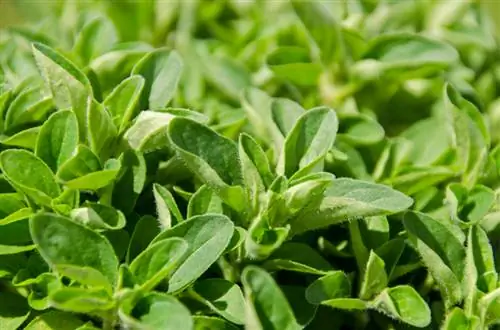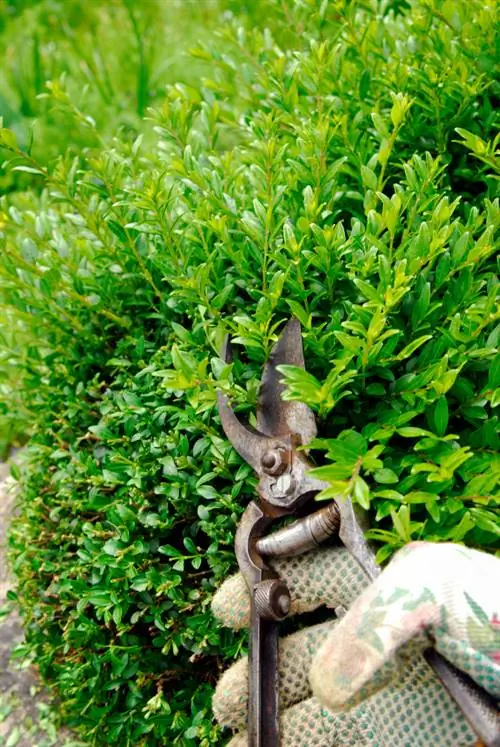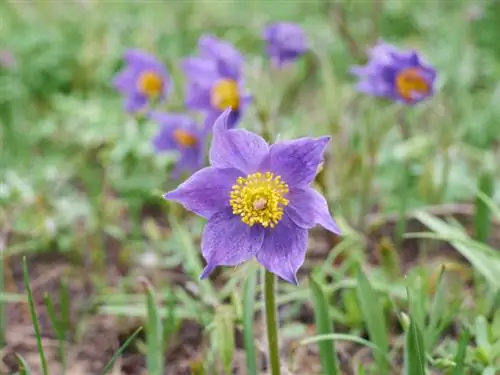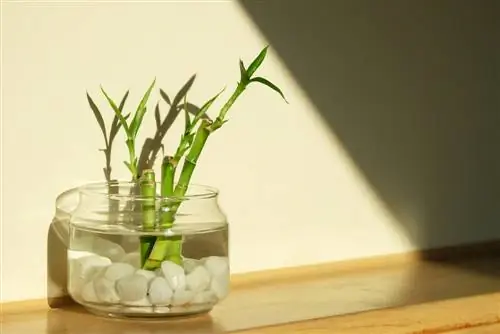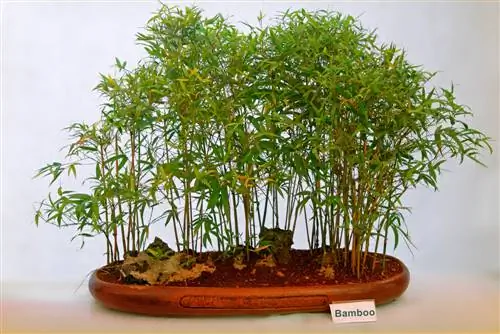- Author admin [email protected].
- Public 2023-12-16 16:46.
- Last modified 2025-06-01 06:02.
Bamboo is very popular for imaginative garden design. When it comes to pruning care, the Asian perennial is treated neither as a woody plant nor as a conventional ornamental grass. Read this tutorial on when and how to cut bamboo in an exemplary manner.

When and how should you cut bamboo?
When cutting bamboo, dead and fading stalks should be thinned out at ground level in spring. Umbrella bamboo can be shortened if damage is caused by snow load, while hedge bamboo should be cut gradually. Dwarf bamboo should be rejuvenated occasionally.
Unusual growth affects pruning care
Despite all the prophecies of doom, you can still cut your bamboo. Before you reach for the scissors, you should familiarize yourself with thespecial growth behavior Although the plant becomes woody over time, its growth differs significantly from trees and bushes. The following botanical aspects influence the pruning care of bamboo:
- Bamboo is an ornamental grass andnot a woody plant
- Growth with perennial, woody stalks
- Evergreen and largely hardy
- Each stalk only grows in height for one growing season
It is primarily the latter point that you should keep in mind when cutting bamboo. According to the law of peak growth, trees and bushes grow a little longer at the tops every year. A bamboo stalk sprouts in spring and has reached its final height by autumn. In the following years, growth is limited to leafy side shoots, depending on the species and variety. Using this route, strong-growing bamboo species reach majestic heights of six to eight meters within eight to ten years - but this growth also always occurs within a single season.
Best time
Bamboo is naturally goodfriendly to cuttingYou can cut off isolated, annoying stalks without hesitation throughout the season. However, if you have given the opulent ornamental grass a comprehensive cut, theSpring will come into focus. With regard to the limited winter hardiness of fresh stalks, the main frost period should be over when you cut bamboo. Shortly before plant growth begins in your region is the best time for pruning care.
Please don't be tempted to attack your bamboo with scissors or a saw in late autumn. According to the laws of growth, every cut causes more or less strong growth. Shortly before winter, herbaceous stalks have no resistance to severe frost and freeze back. The resulting rot affects the entire bamboo.
Cutting flat tube bamboo
Flat reed bamboo (Phyllostachys) impresses with green, yellow, reddish-brown or black stalks that add color to the garden. It is the three to four year old stems whose coloring shines in all its splendour. Older stalks pay tribute to transience by fading colors and weathering leaves. After eight to ten years, a bamboo stalk has passed its peak and gradually dies. At the same time, young stalks sprout every season, so that a continuous rejuvenation process takes place. With planned pruning care you can have a supportive effect on development. How to do it right:
- Partially thin out flat tube bamboo every year
- Cut away dead stems at the base
- Cut off a third or a quarter of the old, fading stalks at ground level
You can master a solid woody bamboo stalk with a sturdy two-handed lopper (€83.00 at Amazon), which ideally has a power-increasing ratchet gear. Alternatively, use a handy folding saw with Japanese teeth. Regular thinning ensures that your bamboo thrives in light, so that young stalks color better and produce numerous leafy side shoots.
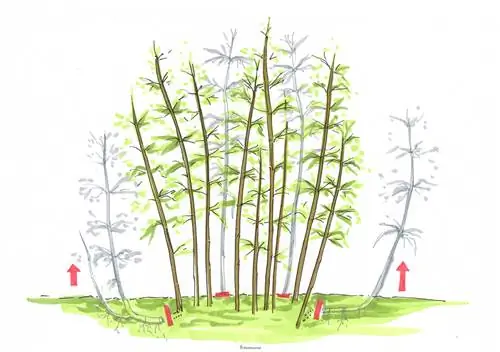
Light out your bamboo every spring. Cut off dead stalks at ground level. At least a third of old, faded stems must also be removed to make room for fresh, colorful growth.
Excursus
Root barrier curbs spread
When buying runner-forming bamboo varieties, a stable root barrier should be in your shopping cart. The optimal length of a rhizome barrier depends primarily on the expected growth height. As a rough rule of thumb, set the length of the root barrier to half the expected height. Dig a trench 65 to 70 centimeters deep in which to lay the non-rotting geotextile. Both ends should overlap by 10 centimeters and are connected with an aluminum rail. It is important to note that the rhizome barrier protrudes a few centimeters. Otherwise, bamboo roots could migrate over the barrier.
Cutting umbrella bamboo
Umbrella bamboo (Fargesia) gives reason for pruning with its dense clumps. If winter brings a lot of snow, the clumps tend to fall apart in spring. Snow pressure has weakened the bamboo to such an extent that a heavy downpour of rain is enough for a number of stalks to bend and protrude unsightly from their shape. The troublemakers can then no longer be integrated. The reason is the comparatively small stalk diameter, which no longer supports the high volume of leaves. How to fix the problem as part of pruning care:
- Cut back stalks damaged by snow pressure by a third or half
- Thin out dead, over-aged stems at ground level
As a result of the reduced weight, shortened stalks straighten up again on their own. Although the stems no longer make up for the height they have lost, they still contribute to a dense, gap-free clump of bamboo with numerous leafy side shoots.
Tip
Lignified bamboo stalks are perfect for supporting freshly planted trees or perennials that are vulnerable to windthrow. Short pieces of stalk are useful as markers for planting sites in ornamental and kitchen gardens.
Cutting the bamboo hedge
When cutting a bamboo hedge, you should always consider its particular growth. In contrast to a hedge made of bushes, bamboo stalks do not grow back up after being cut. Therefore, do not cut the stems shorter than you would like the hedge height to be. You can optimize the privacy factor with a clever step cut. How to properly cut a bamboo hedge:
- First thin out all dead stalks
- Cut the stalks in the middle of the hedge to the desired height
- Trim the stalks a little shorter on the front and back
Over the years, you primarily subject the new stalks to shape cutting so that they integrate harmoniously into the hedge profile. If umbrella bamboo forms a hedge, damage can occur as a result of snow pressure, as with solitary clumps. Shorten the affected stalks with pruning shears or hedge trimmers so that they no longer protrude from the shape of the hedge.
Background
Sap retention promotes dense side foliage
For a bamboo hedge to reliably ward off prying eyes, it is important to have dense side foliage. By shortening a stalk, you cause sap to accumulate below the cut point. Eyes that had previously been dormant become alert and begin to grow busy. When pruning your bamboo hedge in stages, shorten the outer stalks a little more than the stalks inside the hedge. Numerous leaves then sprout in the lower area for perfect privacy protection right down to the ground.
Rejuvenate dwarf bamboo occasionally
Dwarf bamboo (Pleiobastus pymaeus) is very popular as an evergreen ground cover in the creative design of Asian gardens. As long as its invasive nature is kept in check with the help of root barriers, the small bamboo species proves to be easy to care for.
Dwarf bamboo is no more immune to the natural aging process than its big brothers. When the stalks die back and the leaves fade, stimulate growth with a thinning cut. You can either cut out over-aged areas or carry out a complete cut back close to the ground. Thanks to vital growth power, you can rely on strong, fresh shoots.
Topiary cutting on bamboo - is that possible?
Good-natured pruning tolerance and impressive growth vigor qualify numerous bamboo species and varieties for topiary pruning. Creative home gardeners like to give their umbrella bamboo a spherical shape. A wavy hedge topiary can be achieved excellently with a variety of Fargesia varieties. For this purpose, you should rotate the scissors several times per season. Give your bamboo a year or two to establish itself in the location.
The first cut is done in spring before the new leaves sprout. Only when your bamboo is completely leafed do you carry out the second cut. After another four to six weeks, you will complete this year's topiary. In the following year it is enough if you devote yourself to the new growth to give it the desired silhouette.

Frequently asked questions
Should bamboo be planted with a root barrier?
Not all bamboo sends out its roots to take over the garden. Various species and varieties thrive as clumps and avoid invasive growth with runners. The peaceful bamboo species include all Fargesia varieties. If you plan to plant Phyllostachys bamboo, the use of a rhizome barrier is strongly recommended.
Is bamboo hardy?
Bamboo varieties suitable for gardens and balconies are usually hardy. Well-rooted specimens tolerate temperatures down to -26 degrees Celsius very well in the bed. Only shading against sunlight is advisable to prevent drought stress. An exception applies to bamboo in pots. The exposed position of the root ball makes it vulnerable to frosty temperatures. Ideally, you should clear the plants away in good time. Alternatively, wrap the bucket with fleece or bubble wrap and slide a wooden block underneath.
Do I have to cut an umbrella bamboo after planting and tie it up for the winter?
Neither. Bamboo is an ornamental grass and not a woody plant. Pruning to promote branching is not necessary. To ensure that umbrella bamboo survives the cold season safely, we recommend a shade net in the first and second year to protect against drought stress in the blazing winter sun.
I would like to plant my bamboo hedge with small ornamental grasses. Which varieties are suitable?
The Japanese sedge (Carex morrowii), especially the variety 'Aureovariegata' and the white-edged sedge (Carex foliosissima) 'Icedance' are highly recommended as underplanting. The carpet cotoneaster 'Radicans', ground cover cherry laurel (Lonicera pileata) or the low wreath spar (Stephanandra incisa) 'Crispa' also lie decoratively at the foot of a bamboo hedge.
Can I cut the top of bamboo if it grows too tall?
This is possible without any problems. The best time is in spring, shortly before budding begins. However, you should be clear about the final height because once the stalks are shortened, they no longer grow taller.
Our two umbrella bamboos are light green after a harsh winter, shedding leaves and rolling up the remaining leaves. Are the plants frozen? What can we do?
Shedding and curling of leaves after winter is nothing to worry about. Severe frost causes drought stress on bamboo. The evergreen leaves continue to evaporate water without the roots in the frozen ground being able to provide replenishment. Consequently, umbrella bamboo reduces the evaporation area by rolling up its leaves. Severe frost causes the plant to drop some leaves. Just in time for the beginning of spring, fresh stalks emerge from the root ball and the leaves roll up again.
The 3 most common cutting mistakes
If you lump bamboo together with conventional grasses, you are making one of the most common mistakes when cutting. Other common mishaps are due to an unsuitable choice of date and the complete avoidance of an incision. The following table summarizes the three most common cutting errors with information about the damage and how to prevent it:
| Cutting errors | malicious image | Prevention |
|---|---|---|
| cut back radically like conventional ornamental grass | Total failure | lighten occasionally, shorten only if necessary |
| never cut | premature aging with fading stalks | thin out over-aged, pale stalks |
| cut in autumn | Frost Damage | Cutting bamboo in spring |
Tip
Sacred bamboo or heavenly bamboo has no botanical or horticultural connection to real bamboo. In fact, it is an evergreen, unreinforced flowering shrub from the barberry family. Nandina domestica grows to a height of 150 to 200 cm, blooms in early summer and bears red berries in autumn. The name refers to its frequent use in Japanese temple gardens.


